What Is Product Management? Complex Guide for 2022

Introduction
Contents
Many people often wonder what product management is, and how it can be used to help ensure new products prosper. That’s why we have written this guide to help you gain an in-depth understanding of product management, and what makes a successful product manager.
If you’re looking to learn about strategic product management, when to hire the product squad, and how to do product management effectively, this page will cover all of this and more.
What is product management?
Product management is an important part of the product life cycle.
It’s involved in every stage of the process, from the discovery phase, through development, to the release of the product.
Product managers oversee the whole process and take part in a range of product management tasks in the day-to-day workings to manage the product and ensure it is a success.
Product management is all about building a shared understanding with the product team and stakeholders about:
- What are you building?
- Who are you building it for?
- Why are you building it?
The product management basic concepts can differ depending on the industry. For instance, hardware product management and digital product management are similar when it comes to the expected outcomes, however, they differ in terms of process execution.
The main differences cover:
- Product development cycle
- Product definition and testing
- Financial involvement
- Internal/external stakeholder management
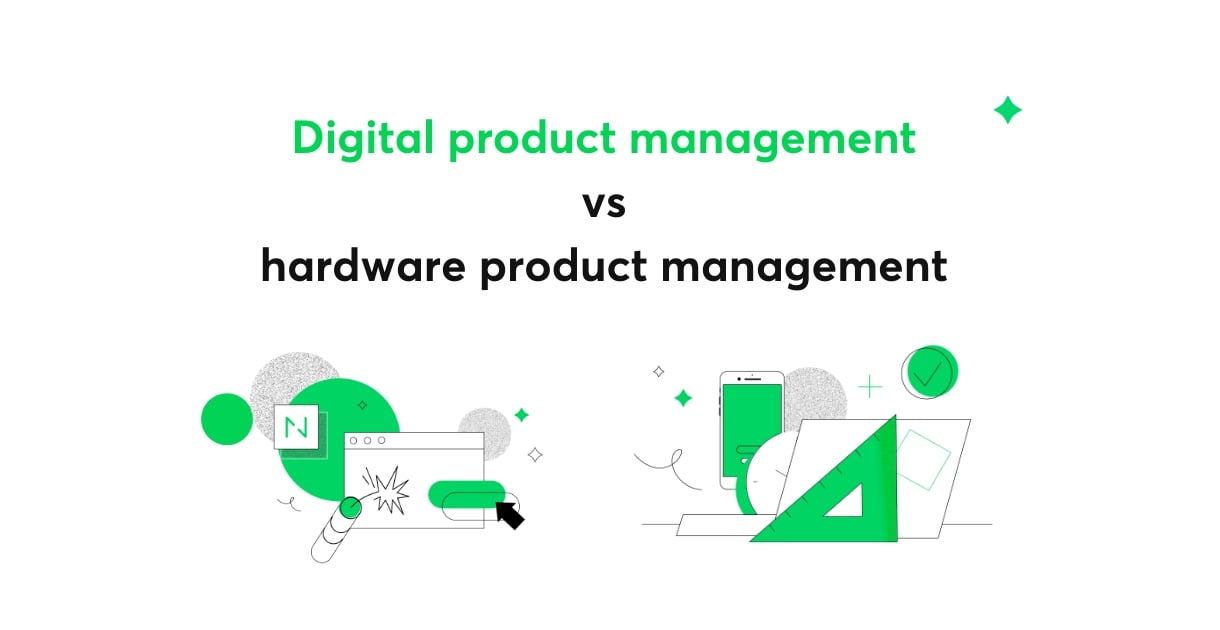
The origin of digital product management
Although you may think that product management has been around for a very long time, it was first created by a manager at Procter & Gamble in the 1930s.
He felt that there should be specific managers for certain products to oversee the process and guarantee that it will be profitable.
This was then slowly developed over time until in 2002, Agile product management was created. This framework was designed with the new technological advancements of the 21st century in mind and was applied to software development teams in particular.
This form of product management aims to set the product strategy and create detailed roadmaps of the process by applying agile methods. Through the old system, the life cycle was slowly done step by step.
The agile process allows for a more flexible way of working and allows for the product management plan to be changed along the way.
This process then led to digital product management, which uses all the above practices to ensure digital products are a hit with the target audience when they go to market.
Why use digital product management?
Product managers ensure businesses build the right products that customers want to buy. According to Harvard Business Review, 95% of digital products fail with 35% falling short due to a lack of market need.
With an increased customer and design focus that’s data-driven, decision-making product management will be a crucial element for developing and launching a market success product.
Thus, product management helps:
- Reach a product-market fit
- Align market needs
- Boost chances of product success through product idea validation
- Research and understand the market
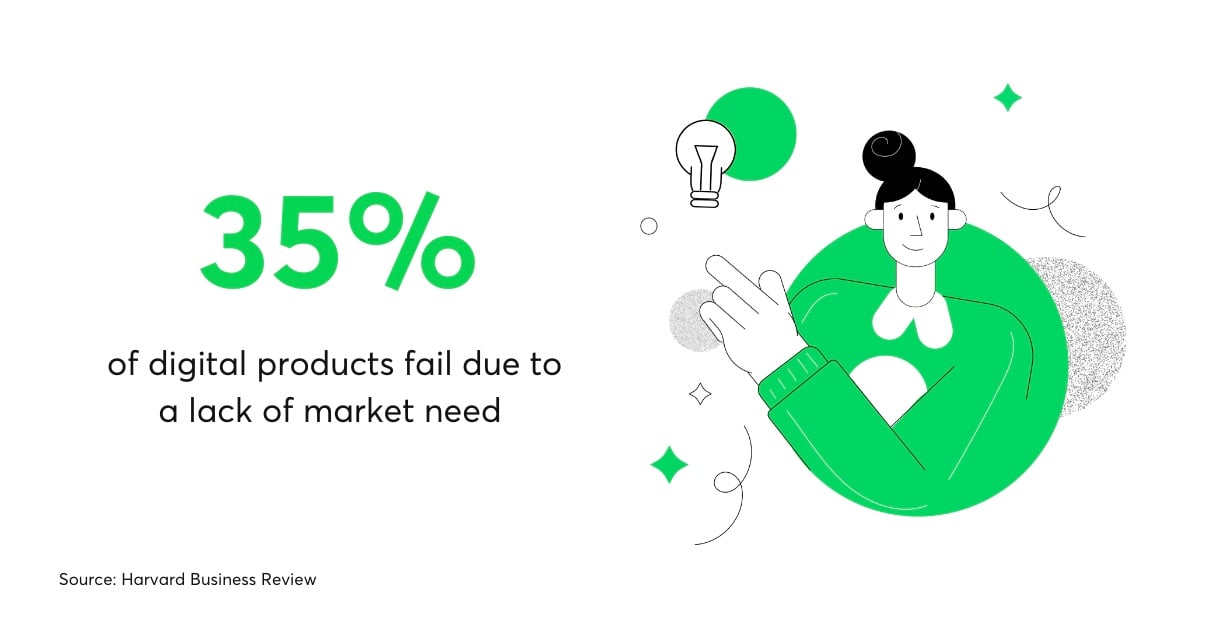
Throughout the entire process of a digital product’s life cycle, a digital product manager is assigned to oversee all aspects of it. They ensure the process moves efficiently from start to finish while looking to achieve the best possible outcome.
Digital product managers are responsible for a variety of tasks that require a diverse range of skills to execute properly.
This can include but is not limited to:
- Product architecture
- Customer development
- UI development
- Supply chain management, and much more.
There are many essential skills brought by product managers which are integrated into the development process.
The role attracts individuals from many different backgrounds such as software engineers, salespeople, marketers, fresh graduates, and others.
Therefore, helping diversify the pool of digital product managers, providing more choices for companies when looking to utilize the right one.
One of the core skills digital product managers come equipped with is digital product management thinking (also referred to as DPMT).
This allows for analytical, business modeling, design thinking, and coordination, all of which are needed throughout the entire process.
Design thinking has always been considered a fundamental skill needed exclusively for designers.
However, digital product managers focus on design thinking as it provides a problem-solving outlook to reduce and prevent complications throughout the product’s duration.
Lastly, is the impact of lean and agile development that is incorporated due to digital product managers. By implementing these approaches, decision-making can be done quickly and any tension within the team can be resolved fast.
When to hire a product manager?
Businesses should consider hiring a product manager when they want to bring a new and effective product to market or develop an existing product. It can be either: building, measuring, or improving a product.
It can be a startup or a large organization that needs to create a product strategy, identify market needs and customer pain points, set business objectives that a new product can fulfill, and turn product vision into launching a successful product.
It’s also worth hiring a product manager to create a product culture in the company. The person navigates different organizational structures, manages stakeholders’ expectations, interacts with sales and marketing departments, and influences without authority.
There are a few milestones during company growth that indicate the need for having a product manager onboard:
Startup funding
To begin operating and succeeding, startups need to get their business off the ground. To be able to do this a startup needs to show investors that they can stand out from the crowd. This is the main reason why product management is crucial for the startup funding phase.
A product manager sets a product vision, helps understand competitors, conducts the product idea validation, leads the team towards the company’s goals, and makes sure that the product meets the market’s needs.
This person helps show investors that the product will solve customers’ pain points. In other words, a product manager will help prove how innovative the idea is and demonstrates it’s worth investing in.
Many startups experience wasted investment because they focus on building products that customers do not want to buy. For that reason, investors want to know if a product will be a winner in the market.
Product management focusing on the discovery phase will increase the chances of receiving funding.
Struggling with user requirements
Lack of understanding of user requirements is a recurring issue for startups. Collecting user feedback is a pillar of product management.
Product managers have the skills to gather, analyze, and interpret user feedback. The person directs the company's attention to the real customer pain points and creates a strategy for a product that customers desire.
It is important to note that a product manager focuses on user recruitment through the entire product lifecycle.
They talk to customers at every stage of product development because receiving continuous customer feedback is key to creating a product that meets changing customer needs.
Rapid growth
It is also worth hiring a product manager when a business plans to increase the existing product’s value and user base. In this case, product management is focused on growth, helping an existing product to be more successful.
The role of a product manager is to help acquire new users, increase retention rates, validate ideas for new product features, and boost revenues.
Thus, a growth product strategy will look different than a product strategy for a startup because it focuses on:
- Increasing product’s value
- Finding new ways to satisfy customers’ needs
- Experimenting with new features and functions
Digital product management examples
Although product management and digital product management sound similar, there are some differences.
Software and web product management is more concerned with digital products. Examples of this range from software apps, tools, or any products developed and designed with the aim for it to be released digitally.
Digital products have many great advantages due to lower overhead costs and higher profit margins on average.
Let’s have a look at the type of digital products below:
Software product management
One example of digital product management in use is when developing software for release to the target audience.
A product manager is responsible for all aspects of developing a software product, to ensure that there are no potential issues with the design and development during the entire product lifecycle.
The role of a product manager is also to handle the legal and financial aspects of the project.
Mobile app product management
Mobile apps are yet another example of when IT product management would be used. A digital product manager will be looking to make sure that the app is accessible and has the best user experience possible before launch.
As there are so many different parts that all need to be perfect beforehand, digital product management is key for app success.
Product management life cycle
The duration of a product’s life is a complex, stage-determined cycle. Each phase has certain important factors that must be addressed by the product manager.
Therefore, for the entire lifecycle to run smoothly, they must know when to apply methodologies during the different stages. Along with, ensuring all of the decisions made are in line with the overall digital product strategy.
These stages can be classed as the following:
- Introduction
- Growth
- Maturity
- Decline
Introduction
The beginning of the product’s cycle is crucial to paving the way for success throughout the entire process. No matter the type, all products will need to overcome different challenges, many of which are dealt with by the product manager.
During this stage, teams must be responsive and adaptable. Within this phase, a business will soon be able to identify if there is real potential for the product, or if it’s not going to work well.
Some of the core factors that are worked on during the introduction period include value proposition, removing inefficient features, and enhancing value-adding product properties.
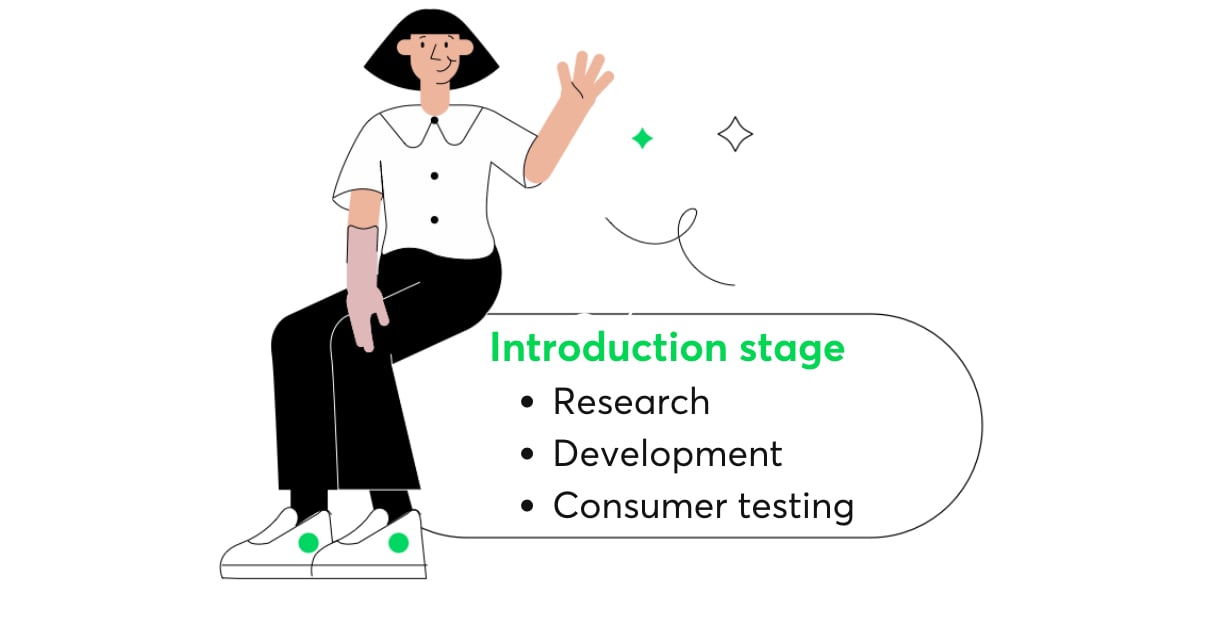
Product pricing at the beginning of this phase can set the course for the entire lifecycle. For example, early adopters that see great potential in products provide the ability for companies to set their prices higher.
However, a lower price can entice more customers into trying out the product. The specific price strategy can differ depending on the industry and product, therefore, product managers are usually in charge to determine the best approach after conducting research.
Another important factor that must be closely analyzed during the introduction is the target audience. Although many companies have a particular demographic in mind, this can soon change once the product is released.
Data insights can be monitored to gain an idea of who the best target market is, helping modify the product for their user requirements.
Costs are typically at their highest point during the initial phase, along with profit being its lowest.
This is due to the amount invested in developing the product to meet expectations, along with high marketing and sales fees. Once a finished product arises and sales begin to increase, then the product will enter phase 2 of the life cycle.
Although product managers do not always get involved with the marketing side of the product, they still are seen as a reliable source to answer any questions related to the product and its functions.
Therefore, when looking into what is product management in marketing, marketers are trying to sell a new product. Thus, gaining product manager support by providing access to this information ensures the marketing team succeeds.
Growth stage
Products that have reached this stage have demonstrated that they have a place in the market.
Marketing is seen as a core focus of the company to help reach a larger audience through all channels. Different approaches are tried until enough data is gathered to determine the highest ROI method.
The growth stage also should include an increase in profit margins as the company takes its place as an economy of scale. The contributing factors for this taking place consist of overall manufacturing costs declining as the product creation processes become streamlined.
However, industries can differ, and depending on the competition in the sector many companies will see profit margin increases vary.
During this time, product managers have numerous responsibilities to ensure the process runs smoothly. As the product grows, competitors will start to adjust their approach.
Therefore, high attention to detail is given to identify the best product price that will continue to attract the most customers without undercutting any unnecessary margin amount.
In addition to price, another core task that must be closely examined during the growth stage is the ability to expand product reach. New audiences can be identified as new product changes are developed during this phase.
As high amounts of data are available for insights, product roadmaps can be modified when new opportunities are located.
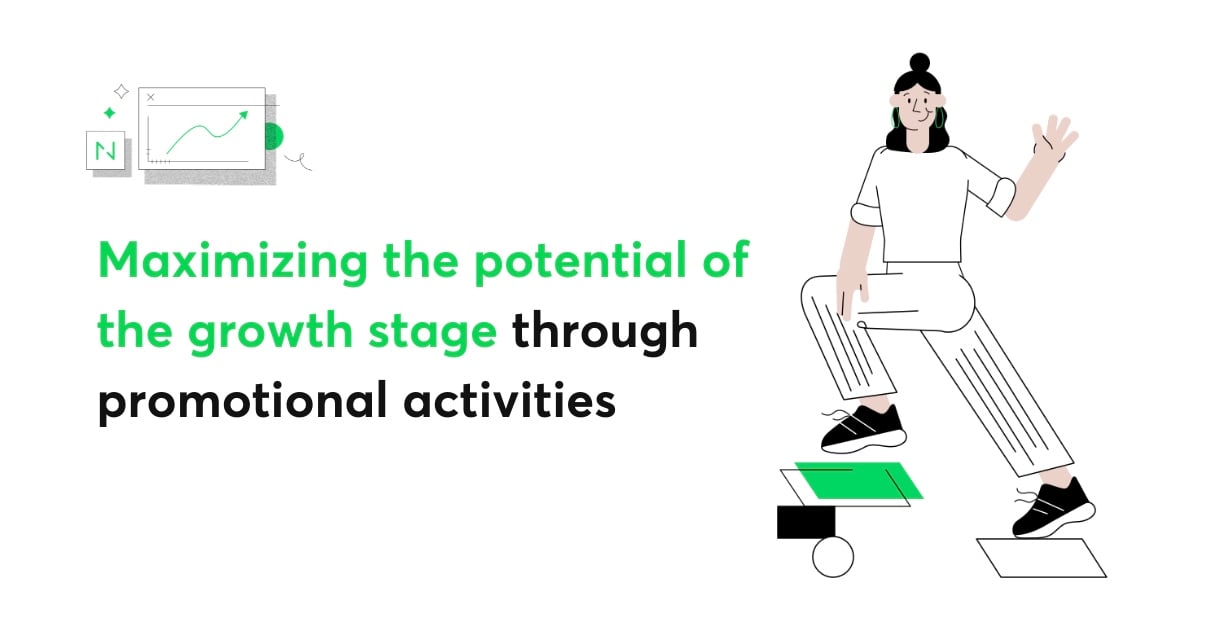
Overall, the results achieved during this stage are gained by further increased marketing and advertising.
However, with revenue going up, it’s down to the corporate product manager to ensure that a portion of the returns is invested back into the product. This way, the product keeps improving to meet user requirements while meeting the new demands as the business scales.
Technical skills applied by the product manager throughout this phase contribute directly to how much growth is experienced. Otherwise, new trends embedded in data won’t be noticed.
Maturity
The next phase is maturity. For many businesses, product maturity is the stage they want to achieve. Although, there are definitely some drawbacks to leaving growth and reaching maturity.
For instance, new customers interested in the product begin to slow. Typically, this is due to a combination of factors, such as competitors taking some of the market share and a large portion of the intended audience already being targeted.
Therefore, for maturity to be successful for businesses, they must focus on retaining their customers by keeping them interested in the product.
To do this effectively, the product manager needs to implement the necessary skills to prevent decline.
Analytical skills are needed during this stage to help determine different processes that can be improved, which reduces costs incurred by the company.
Furthermore, trends and patterns must be continuously reviewed just like the growth stage, to ensure the product stands out in the market.
To start with when a product manager is looking to reduce the cost of goods sold, each operational process is inspected to see if a more efficient approach can be applied.
We’ve highlighted a few below that are usually examined:
- Customer support automation
- Onboarding
- Development team structure
The product's features must be reviewed constantly to determine which aspects are best to invest in, thereby increasing ROI.
This is made possible by either targeting the existing target audience with product extensions or focusing on a new market with additional unique selling points.
Analytical data gathered plays an important role in maturity, just like the growth stage. The difference between this information being used can significantly alter the company's life cycle between this stage and the decline phase.
This can be used to determine what value-adding components are generating income and other features which are dragging the product back.
Marketing campaigns can also use information acquired from user behavior to enhance their effectiveness. All of which are key to keeping clients happy with the product for a long period of time.
Decline
No business wants to enter the decline stage, however, it happens nevertheless.
There are many reasons that cause products to enter the decline stage. Whether it be the lack of demand from the market or better alternatives.
During this period, there are certain aspects for the product manager to focus on. Firstly, the problem causing the decline must be found, allowing for an appropriate response.
If the market is becoming smaller, then research is often undertaken to find new market opportunities that are available with the company’s existing technological capacity and equity.
However, if the decline is due to the product itself another approach must be tried.
When the product is concerned, some businesses decide to expand the product range to combat the decline. Using the industry knowledge collected, product managers can determine other product possibilities.
For example, Apple diversified their product range from focusing on desktop computers to the mobile phone market.
This approach is not always viable when in the decline stage, therefore, other options must be considered.
Product managers can attempt to re-ignite customer interest in the product by getting old customers excited about it again. Achieving this is done through a well-executed marketing campaign.
Whereby, certain features that were well received previously can be improved by the product team and then advertised.
Unfortunately, not all products survive the decline phase. Therefore product managers must be active in the withdrawal process to prevent high losses.
Some products have legal and fiduciary commitments that must be upheld to existing customers, and the product manager must ensure these requirements are met. This includes providing refunds when necessary, transferring customer data, and suggesting alternatives.
Product management strategy
Strategic product management is where a vision for the product is created and carried out throughout the life cycle. However, there is usually not one single strategy that is used.
Multiple strategies are employed as the product goes through different stages and slowly gets carved into the best possible strategy for the product.
But how is a product strategy created? It goes through a few processes before arriving at the best course of action. Take a look at these processes below.
Ideation
This is the starting stage and is where brainstorming and product idea creation begins.
Here, product managers find their product vision and create a business model in order to improve and refine the product roadmap whilst getting an idea of how to build products that customers want.
When the product vision is concerned, there are a few things to think about.
Firstly, knowing who the customers are to target, and the potential strengths and weaknesses of the product are all necessary to build a strong and lasting product vision.
A business model takes the product vision and builds upon it further creating a more in-depth look into the product as a whole.
This can include everything from the mission statement to the overall marketing strategy of the product in question.
Analysis
The next stage in forming a great product strategy is the analysis stage. Here, the customer is the focus, where the analysis of the target audience is needed in order to create a product that best appeals to them.
Goals and achievements
After gaining all the information from the previous two stages, this part is where the goals are set, and attempting to figure out the best strategy for achieving this.
After taking all these three into account, a strong in-depth strategy of how to navigate the product management process and ensure the product comes out on top should be made.
However, just because the goals have been set, doesn’t mean that it should be left alone. Constantly looking back and tracking them to make sure that the product is on target is necessary.
What is product discovery?
The product discovery phase is right at the beginning of the product development process and is where product managers decide whether a particular product should be developed.
There are many different things that these managers can do to ensure they make the best decisions possible in this stage.
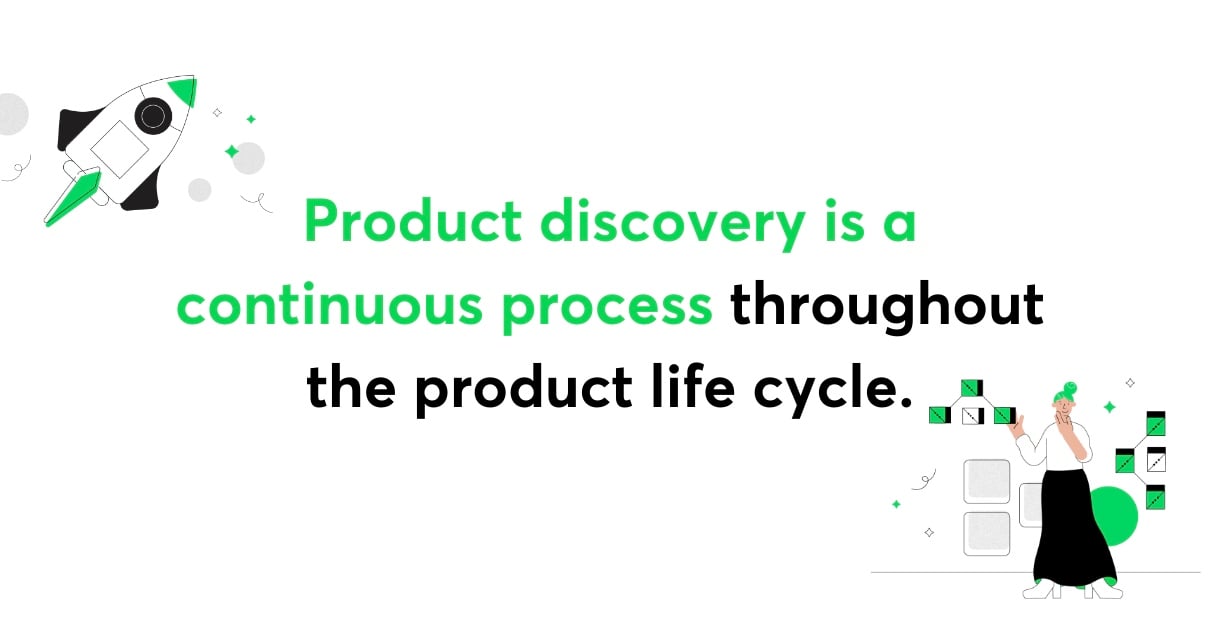
Creating the discovery team
Before deciding upon which product should be developed, creating the right discovery team to aid in consulting and using their knowledge throughout this process is a must.
It’s a good idea to have an even mix of those in different roles to ensure that every element of the product is sufficiently catered to.
For example, you should include the following:
- UX designers and researchers
- Lead developers or technical experts
- Marketers and growth specialists
- Sales managers
- Data analysis
- Field experts
Assess for issues
After the team has been set up, it’s time to think of the business model and the main goals that the product should achieve.
As well as this, product managers also need to take a look at the product to ensure that it is something that the target audience is likely to buy. If the wrong audience is selected, or the product isn’t quite right for that group, it is likely to fail.
Once these are both catered to, the next stage would be to look at the product in question and ask yourself: what are the main problems with this product idea which may lead to low sales if it is released?
Planning
All businesses want their new and potentially profitable products on the market as soon as possible. Because of this, the product discovery process needs to be streamlined as much as possible.
This can be done by only completing the most important tasks, therefore, answering: why is product management important.
No matter how long is spent on crafting and perfecting the product, the only way to really know if it’s great is by receiving customer feedback. However, there needs to be a balance.
Ensuring you have a good grip on the product, its business model and goals, whilst knowing that the target audience will enjoy using it is key here.
Product discovery is a long and complicated process. Due to this, it is often a good idea to map out and plan when everything will be done to ensure it is completed as efficiently as possible.
Including regular meetings in this plan is a great way to keep everyone involved on the same page, and working towards the same goals.
Customer feedback
For seasoned product managers, it won’t be too difficult to get high-quality feedback from the customer, but for inexperienced ones, it can be a struggle to get the necessary information.
As mentioned earlier, making sure the product resonates with the customers you are targeting is the most important factor.
Because of this, it is quite important to talk to your target audience and understand what they like and dislike about the product, to ensure that changes can be made before product release.
With customer feedback, it is important for the product manager to take a deep interest in the customer, and write down all their issues and concerns.
The customer is the most important group of people that will affect the product's success, whether that be positively or negatively.
What is proof of concept?
An important part of the discovery phase is a proof of concept (PoC): a software development testing methodology that helps businesses make rational decisions about the creation of a new software product and define its future.
Can x solution exist? The purpose of the proof of concept is to test the validity of the software idea - it’s all about proving that the proposed system, application or product can work in real life before you begin development.
A proof of concept is absolutely essential to define the vision of the final product and its orientation. Because of that, it should involve all stakeholders engaged in the development process.
They get together to discuss the limitations, opportunities, and risks, as well as to agree on the direction of the project. It’s an important step in laying solid ground for a smooth development process, testing, modifications, and launch.
The benefits of proof of concept in software development:
-
Assessing technical feasibility
-
Understanding product limitations
-
Making rational budget decisions
-
Having a reason-to-believe
-
Accelerating the release
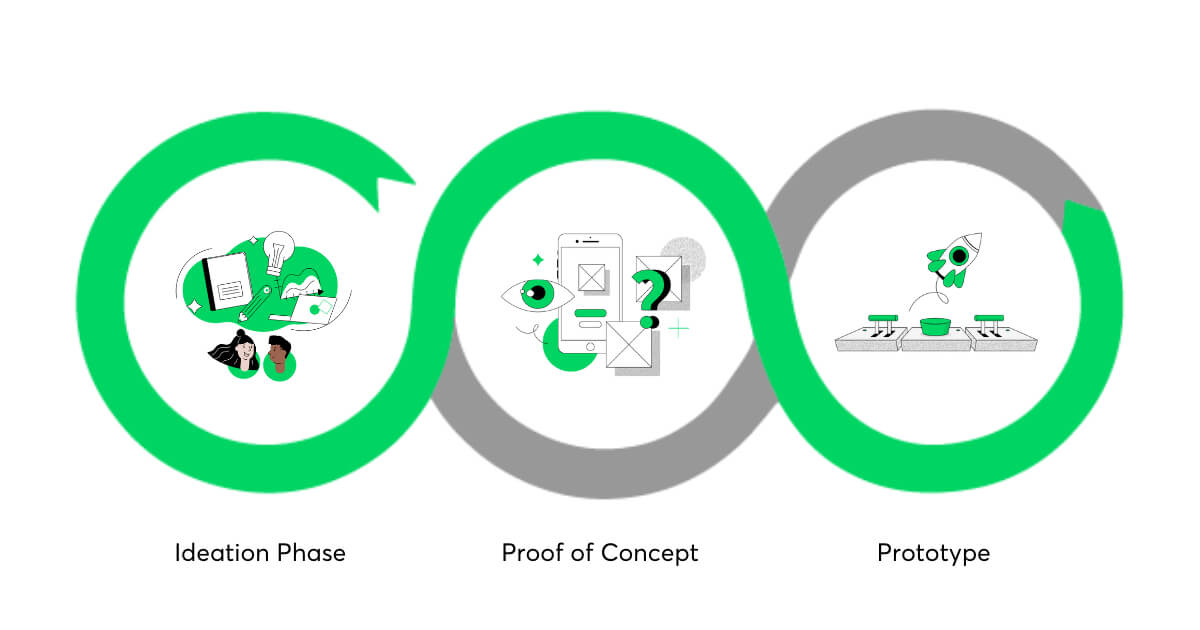
When does the product discovery phase finish?
Although for many the product discovery phase finishes as soon as the product is released, more and more businesses are using the product discovery process all throughout the product life cycle.
This is especially true in the maturity phase. To ensure the product is continuously successful, constant changes are needed to adapt to the ever-changing marketplace.
To do this, reviewing product feedback allows you and your team to think about how the current strategy and roadmap can be changed and adapted to the new trends in the market.
This process will allow the product to have a much longer life cycle than originally imagined.
- What is the market you are entering like at the moment?
- Is there a large demand for the product?
- Have your competitors tried to solve the problem before?
What is product validation?
Product validation is closely linked to the product discovery process, in that you’ll be validating whether the product you are creating will appeal to the target audience.
Are there potential customers, who would like to buy x solution?
It helps with refining your ideas, much more so at the end of the process, you would have a much better idea of what the product is, and how it will be a success when it’s placed on the market.
When validating the right product ideas, the first thought should always be about the target customer.
What is the market you are entering like at the moment? Is there a large demand for the product?
Product managers need to think of all these questions relating to the customer when coming to an informed decision.
If there is not enough demand for the product, this may harm the chances of the product idea moving forward.
But how do you effectively validate the demand for the product?
This can be done in a range of different ways, however, constantly receiving feedback from potential customers, looking at market reports, and seeing what competitors are doing is very important in understanding and validating the demand of the product.
Validating customer problems
To be unique and stand out in the market, product managers need to find a problem that customers face and work on solving that problem by releasing a product.
This stage is where you need to be out on the street talking face to face to customers and understand exactly why they are unhappy with the current competitor products on the market.
This gives product managers a great idea of what the main issues are, and how the product can be developed to solve these problems.
Final product validation stages
After completing these above steps, the product is close to being fully validated. The product validation stage is where all the steps before are double-checked so that the validation steps above are accurate.
Creating a prototype is the logical next step in the validation process. Before, you could only give customers an idea of what the product would look like.
Now, showing a real prototype may give them more ideas and more problems when it comes to the product.
The feedback gained from this process may change the whole design and functionality of the product.
This is a good thing, as it allows the product to be refined more to make sure it performs as best as possible. This process may also change the target market.
If different groups have different things to say about the product, or you realize that the product best solves a problem in another market, the product manager may decide that targeting a different audience would be the best approach.
After you have validated the product enough times, gone through the stages, and now have a good idea of the success of the product, you’re good to go!
Product development
Many often wonder about the differences between product management vs product development. Within product management, product development plays a key role.
Also known as new product development (NPD), It consists of all phases a product goes through from the initial idea to its release and more. In other words, it’s the entire journey the product goes through.
There are certain stages that can be identified during product development. Keep in mind that is different from the overall company lifecycle.
Finding the need for the product
Products are designed to become easy solutions for problems. Therefore, when brainstorming ideas, it must have a clear USP that current products aren’t fulfilling.
To ensure businesses are on the right track, focus groups, surveys, and other research methods are undertaken to provide tangible evidence that the product has potential.
Investigating product relevance
Although the product may solve a particular problem, will customers see enough value to purchase it?
Understanding this crucial factor early on in product development can minimize potential risks before the company begins to invest heavily in the new concept. I’m
Envisioning the product
Once relevance has been obtained, it’s time for the product team members to bounce ideas around to make some very rough drafts of how the product may look and work.
Product roadmap creation
The next step is producing a robust product roadmap. This entails meeting all the necessary targets that are crucial to the development of the product. Therefore, promoting the value of the product once advertised to gain the attention of early adopters.
Building upon research
Before time and effort are put into prototyping the product, the new product idea should be discussed with the target market.
Many aspects can change going forward, with the product being altered or the target audience changing. However, to ensure a less risky investment, there should be enough data highlighting that individuals like the concept of the product from the research.
Minimum Viable Product (MVP)- is the simplest possible version of your product which aims to solve a problem. It is an early product version that has just enough features for early customers to be able to use it.is a key step to avoiding this failure.
It helps you to gather feedback from your potential customers and identify what they truly need from your product. These customers then offer feedback which can be incorporated into future, more developed versions of the product.
Product release
The product is then released to the market. Data can be collected to enhance marketing channels and determine the correct pricing strategy. Along with, identifying any problems that need to be overcome, and new features that can increase sales.
Continuous development
Throughout the duration that the product is in the market, a constant flow of new information will be gathered from the users.
This can directly impact the initial product roadmap, causing it to evolve due to the new strategy implemented by the business. Only when the product is discontinued, does development stop.
Product delivery
Product delivery is mainly focused on solving many of the issues that customers may be facing with competitors’ products and getting them out there on the market for everyone to see.
Delivering the product to customers is a difficult yet essential task to get right in guaranteeing that there is a continuous flow of products being released into the market.
Although the development stage must not be rushed too much, it is extremely important to time the release and delivery of the product.
If the product isn’t released at the right time, it could massively affect its performance. It needs to coincide with when the product would be most used and be most convenient for the customer.
Also, if the demand for the product is really high, but the product doesn’t release for a long time, this will also negatively affect the product's release and delivery.
Adding on to this, if the landscape for the product is getting increasingly competitive, releasing at a time when it is most competitive may diminish the performance of the product.
For those selling tangible products, it can be hard to organize the operations to ensure that the products get delivered into the market effectively.
However, for those with more digital products, it’s a different story. Although the logistics required for digital products are next to none, ensuring these products can be delivered to the customer without error still requires lots of work and preparation in fixing any potential problems before they occur.
What’s the difference between product discovery and delivery
Product discovery is mainly concerned with finding the problems of the product.
They will use analytics and talk to their target audience in order to understand more about the customer and how to target them the most effectively.
Product delivery on the other hand is more concerned with fixing the errors and finding solutions to the problems found. They will use continuous supply strategies to ensure that the product gets released on time and to the audience that they want to target.
They are both extremely important in the product development process. Because of this, they need to constantly work together in order for the product to be successful.
Having a cross functional team of those two groups and constant communication is quite important.
The discovery team may find a problem and the delivery team will be tasked with delivering a part of the overall solution to see how their target audience reacts to it.
This could then help the discovery team more, as they will know more about what the audience needs, and may change the product based on this.
Roles in a product team
In order for a product to be effective, the right team is needed.
This team is responsible for the strategy, the roadmaps, measuring and monitoring the performance of the product, getting information from focus groups, promoting the product, and building the products, among others.
The product team usually consists of a group of developers led by a product manager.
There are other roles that can be included, such as:
- Product designers
- UX researchers
- Marketing/ growth managers
- Project managers
- Scrum masters
- Product owner
- Business analysts
The role of a product manager in a product team is to lead product oriented development, which can be described as development that is focused on achieving business goals and results.
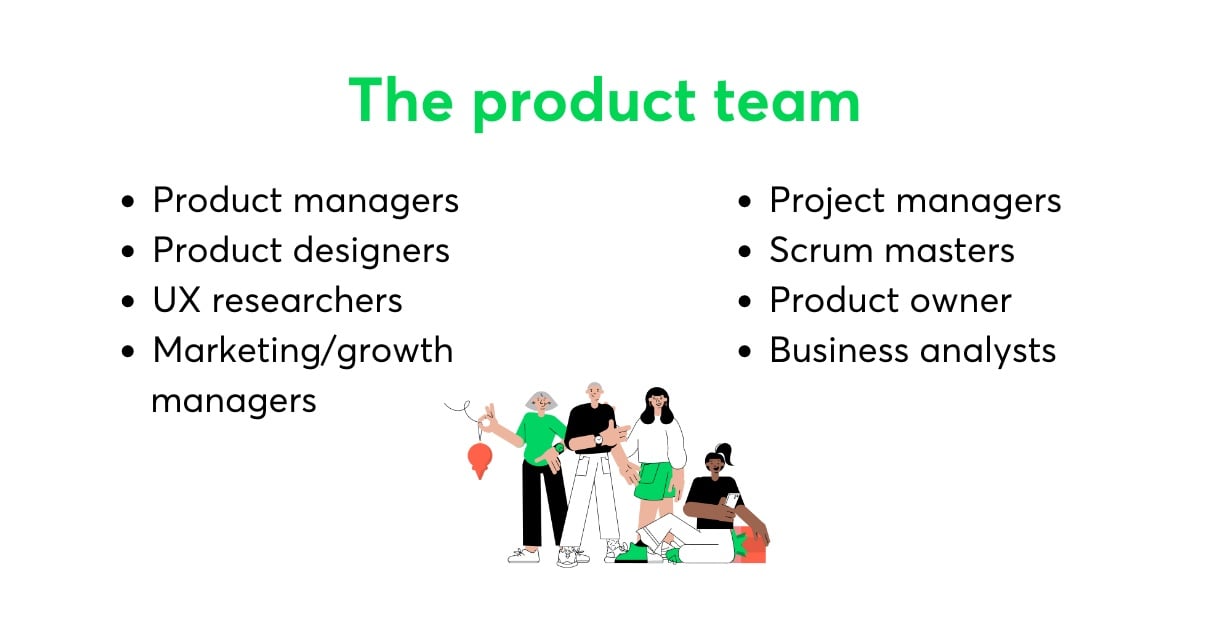
Role and responsibilities of a product manager
We often get asked: what is the role of a product manager? Product managers have a large scope of duties that fall into their daily operations.
Overall, the role of a product manager can be defined as an individual that guides a product team in the successful creation and development process of a product. Whereby, meeting customer needs and business objectives.
The role is a relatively new addition to the traditional business structure which was originally controlled by CEOs or business owners. Therefore, as time progresses, the definition of the role may change to add additional core product management functions.
The product management responsibilities can differ depending on the sector, size of the business, and more.
For example, larger businesses put product managers in the middle of specialist teams. These teams consist of marketers, analysts, researchers, designers, and developers.
By doing so, they are aware of all different components that directly impact the management of the product, helping keep the teams on the same page when it comes to the overall strategic approach that’s been decided.
Smaller companies are a little different. The digital product manager’s responsibilities shift from making sure all teams are on the same page to implementing the idea and moving forward with the product.
There are some universal product management tasks list that all product managers will be in charge of.
These consist of the following:
- Finding out user needs and ensuring the product meets them
- Checking for market changes while analyzing competitors
- Roadmapping the product
- Ensuring all stakeholders are on board with the direction of the product
- Implementing value-adding features
- Assisting relevant teams to make the correct decisions
Tracking product metrics
A big part of the different product management steps is analyzing customer data to further optimize the product.
New avenues can be identified and poor performing features can be changed. This is all achieved through carefully tracking product metrics.
This is one of the most important product management activities. The core product metrics that are routinely checked by a product manager are engagement metrics and business metrics.
Engagement metrics
These types of metrics are used to determine how customers interact with the product and their satisfaction level when doing so.
The product’s adoption rate is analyzed to determine the percentage of users that move from the interest stage to regularly use the product. This helpful data identifies features that are attracting customers, therefore, assisting developers on what to enhance.
Daily Active User/Monthly Active User (DAU/MAU) statistics help measure how often customers are using the product. For new tech-start-ups, this insight is especially useful to help configure digital products.
Finding out the business’s conversion rate is a big part of product management. Therefore, close attention is always given to this factor for digital products. The conversion rate helps the company see how many visitors it takes before they purchase the product.
Sessions per user are typically used alongside DAU to see the average number of times a user is using the product or visiting a website/app.
It provides more valuable information upon daily or monthly usage to determine overall user engagement. All of which help shape the product to the intended audience.
Lastly is the net promoter score that is commonly known as NPS. This helps to figure out the overall opinion of the brand and company. Customer satisfaction is incredibly important to analyze to identify any possible problems that are holding the product or business back.
Business metrics
A core business metric used to measure the total amount of income the product receives each month is called MMR (monthly recurring revenue).
Product managers use this metric to forecast cash flow and the overall financial position of the business.
Another crucial metric used is the customer lifetime value (CLV). Its purpose is to understand how much an average customer will spend on the product during their lifetime.
This helps identify how much should be spent on new customers when marketing to ensure the business stays profitable. Different demographics can be targeted to see which provides the highest profit margin, allowing the company to become more efficient.
Customer Acquisition Cost (CAC) is used to figure out how much the average cost is needed to acquire a new customer. It can be used alongside CLV to determine the customer's worth and how much should be spent.
Product manager vs product owner
A product manager can sometimes be confused with a product owner, however, when both are working for the same company, their roles become separated.
Nonetheless, they still both work towards the same goal; designing and enhancing products that provide value for customers.
The product manager is known for attempting to understand user requirements and create a clear plan of what to develop next to add greater value to the product. This is achieved by making a product roadmap.
On the contrary, product owners are responsible for the product backlog, this includes both the creation and management process.
As well as this, the main role of a product owner is to obtain user stories that are created and provided to the development team to give an insight into the voice of the customer during the Scrum process (Scrum is a core feature of Agile framework that focuses on creating and maintaining complex products).
Project managers vs product managers
Many people confuse or use these two terms interchangeably. These two roles are vital for product development but they are completely distinct.
Project managers are more involved in completing the project and getting it done to a high standard within the time frame and budget. However, this is not all they are involved in.
They will also be involved in risk management, planning, and scheduling the resources that are needed to complete the project.
In comparison, product managers are more involved in the direction of where the product will be going.
They need to completely understand the customer and their needs, and have a constant view of the whole process, from creation to release and then maintaining, and eventually retiring the product.
Although a project manager will be overseeing the whole project, a product manager will be focused on the product itself and always staying close to the customer, to ensure the product is as much of a success as possible and meets all the user needs.
In most cases, a product manager will be involved in the entire product lifecycle, while a project manager would be present until a project is completed.
Stakeholders and product managers
Product managers have to meet stakeholders all the time to discuss their expectations of the product.
There will be many stakeholders that product managers will have to talk to in order to consider their needs, which can include the below and more:
- Developers
- Sales managers
- Designers
- Higher management
- Investors
- Users
- Marketing managers
- Lawmakers, in industries with high protectionism and legislation
Everyone on this list will have different priorities when it comes to the product, so having to satisfy all of them is one of the hardest parts of being a product manager.
But not only will you need to satisfy their different needs, but must also need to employ a different approach each time when communicating with the different levels of stakeholders.
Stakeholder management
When talking about digital product manager skills, good communication is a must when stakeholder management is concerned.
But what’s the best approach for communicating with these different stakeholders?

As we mentioned earlier, there are different levels of influence and interest depending on the stakeholder.
A stakeholder matrix is used for this very topic, which will be helpful in the decision-making process when wanting to satisfy a particular stakeholder.
If a stakeholder wants a particular decision to be made, but they are low down on the interest and influence scale, it will be of lesser importance to execute.
This is especially true when compared to someone wanting a particular product decision to be made who ranks much higher on the scale.
Mapping out all your stakeholders on this matrix is a great idea when informing stakeholders and making decisions.
Pleasing those who are high importance and high-interest stakeholders can make all the difference when the product is concerned.
How to become a product manager
For individuals that are interested in becoming a product manager, there are certain universal product management requirements needed even before acquiring product management experience in the field.
Product management how to begin requirements:
- A bachelor’s degree (in any discipline)
- Passion for product management
- The ability to undertake product management courses
For those that apply and do not meet the basics of product management, the likelihood of receiving product management job offers is slim.
Building upon these fundamental requirements, there are other factors that can significantly influence the chance of obtaining product management positions. They include skills, tools, and certifications.
Skills
The key to becoming a good product manager consists of being able to implement particular skills. When starting in the profession, the main product management skills needed are
- Creative problem-solving
- Excellent communication and interpersonal skills
- Strategic mindset
- Team collaboration
- Being empathetic
Tools
Functional product managers rely heavily on different tools throughout their daily operations. First-hand experience with relevant tools can provide a competitive advantage over others when applying for roles.
The common types of tools used have been categorized below:
- Product road mapping tools
- Analytical tools
- Team management tools
- Development tools
- Task management tools
- User experience testing
Certifications
Certifications can provide a good starting point for new product managers. They help prepare them for the role while showing employers that they’re right for the job.
The best approach is to find a course that is tailored towards the type of product in the industry wanted. Although, for aspiring product managers who are unsure of what sector appeals to them, a general course is a great place to start.
Trends in digital product management
Modern product management is constantly evolving as new technologies and processes emerge. Because of this, the future of product management is changing before our eyes.
Take a look below at some of the newest developments in the product management digital world.
The rise of digital products
Year after year, more customers are moving online. In the past, it was way more common for there to be digital product management in the IT industry and other digital-based industries, but now this is changing.
Industries that used to be non-digital have started to depend on digital solutions for increasing their customer base and improving efficiency.
Because of this, new digital products that provide customers with relevant and customized solutions are needed to keep up with this demand. As such, companies are now expected to put more money and focus on product management support.
New product management tools
One thing that drastically changes the efficiency of product managers for the better is product management technology, in the form of digital tools.
With the invention and innovation of new tools and product management software, they will soon be able to become even more efficient than before.
As well as this, they will gain more in-depth customer insights which can be used to make better discovery and delivery decisions throughout the product life cycle.
Product specialization roles
At the moment, product managers need wide-ranging knowledge on a large amount of different topics.
However, as the role of product management is changing all the time, and with product teams growing, it is likely that there will be more specialization of product managers to work on specific parts of the product process.
Improving customer communication
Engaging with customers and gaining valuable insights is one of the most important product management capabilities.
With more companies going digital changing the way managers communicate with customers, online communication has taken center stage.
More communication tools are now being created to have productive conversations with customers, whether online or offline.
Ensure the success of your products
On the surface, product management is a very complex, yet extremely important part of any product being successful.
However, it doesn’t need to be. Its overall goal is to ensure the product is profitable by eliminating as many risks and problems through constant analytics and customer feedback.
As long as the product is routinely monitored and managed properly, it is likely to be a game-changer.
If you are looking to outsource your product management needs, there is a solution in hand.
Netguru can provide you with highly customized solutions for getting your tried and tested products onto the market and in front of your target audience.
Piotr Golianek
Piotr Golianek works as Product Manager at Netguru.

Read more on our Blog
-

11 Smart MVP Testing Methods to Validate Your Product
-
...%20hero.jpg?width=1200&height=630&name=Jetpack%20Compose%20vs%20Flutter%20(With%20Examples)...%20hero.jpg)
PoC vs MVP: Key Differences
-

What is a Proof of Concept (POC) in Software Development?
-

Product Manager vs Software Engineer: Unraveling the Roles and Pathways
-

Essential Product Management Skills for Success
-

What is Product Manager: Roles, Responsibilities, and Best Practices